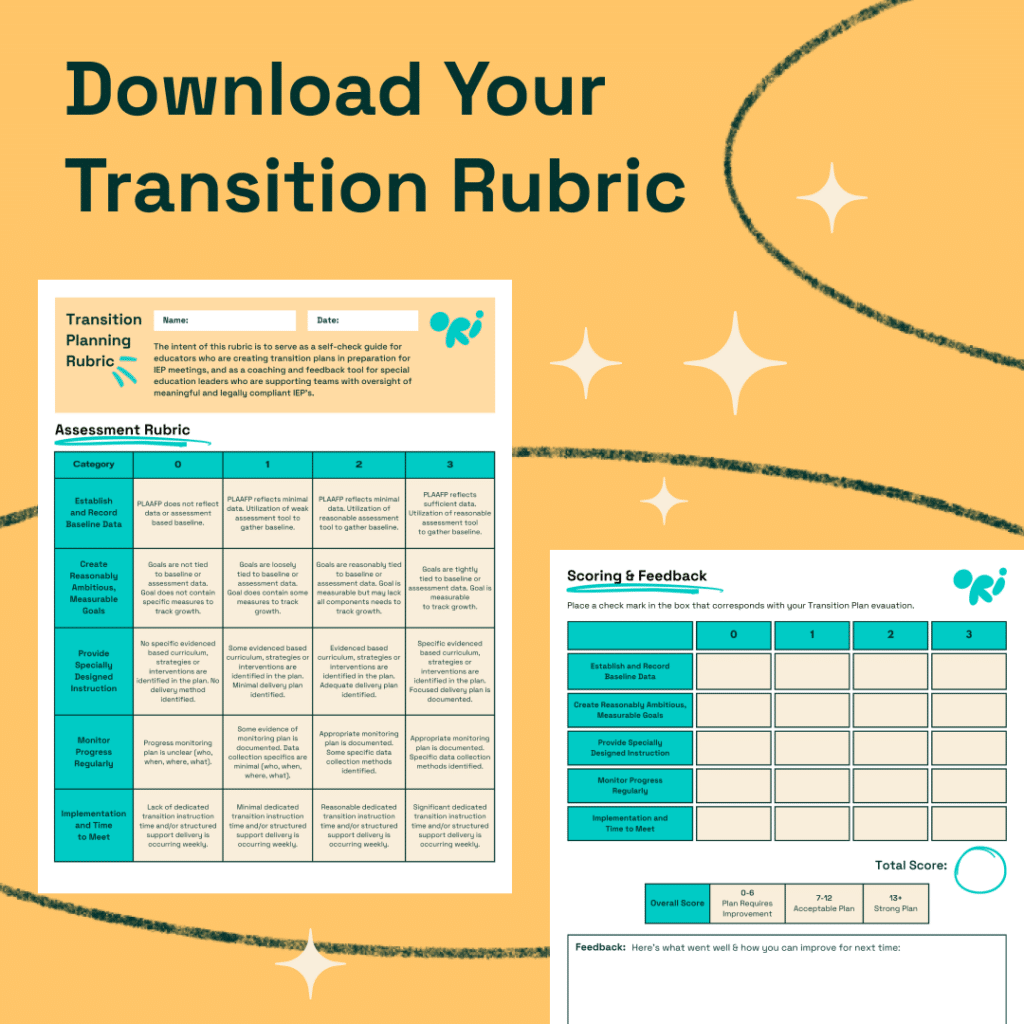

One question that seems to come up often in special education conversations is “Is IEP training required for teachers?” While you might expect this to be a straightforward ‘yes’, things are actually more complicated than that.
In fact, to answer this question, we must first examine the legal frameworks around IEPs and transition at a federal and state level. Aside from legal mandates, we must also consider the practical benefits of IEP teacher training.
In this article we will address these two aspects of the question and we will suggest actionable insights and additional resources for special education directors and transition coordinators who want to keep their teachers up to speed with the latest in the world of IEPs.
As the primary legislature in the field of special education, the IDEA aims to ensure that all children with disabilities have access to a free and appropriate public education (FAPE). It does this by mandating tailored education services to meet the educational needs of each student.
Part of this effort is making certain that the teachers delivering these education services possess the necessary qualifications to do so effectively. In that sense, the IDEA requires that special education teachers must be “highly qualified.” As per the legal document itself, this entails:
While IDEA lays out this foundational criterion, it does not provide a detailed roadmap for IEP training, leaving that up to individual states.
Read more about setting SMART goals and objectives for students with IEPs. Discover useful templates and examples you can start using right away.

Every state has the autonomy to refine, expand upon, or specify the federal guidelines provided by IDEA. While IDEA provides the foundation, state-level directives furnish the intricate details. For example, states can:
Given the variations that exist in state legislature and the not-infrequent changes to state laws, it’s best to consult with State Department of Education websites or to reach out to representatives from these bodies directly.
One direct result of effective IEP implementation that we often see is improved academic performance. Training your teachers in the IEP arena means equipping them with the knowledge and tools to transform a written IEP document into tangible, real-world results. When executed proficiently such training empowers teachers to:
Both IDEA and state-specific guidelines have clear directives regarding the development and implementation of IEPs. Non-compliance isn’t just a bureaucratic misstep—it can lead to costly and reputation-damaging legal challenges.
With that in mind, a thorough IEP training ensures:
Another tangible benefit of such training is improved communication among all stakeholders in the IEP process. As special education directors are aware, an IEP isn’t a solo endeavor. It requires strong collaboration between general educators, special educators, therapists, parents, and the students themselves.
Thus, when all stakeholders have a solid grasp of the IEP:
Looking for a transition solution that requires no additional training for teachers?
So, after discussing the importance of IEP training for teachers, let’s explore what makes such initiatives effective in practice.
Firstly, for any special education training to be productive it must encompass the full range of IEP activities:
Specific emphasis must be placed on goal setting and crafting measurable outcomes.
Another key factor for the successful implementation of IEPs in the classroom is understanding the fine distinctions between accommodations and modifications.
Accommodations refer to adjustments and changes made to the learning environment, instructional materials, or methods to help a student with a disability participate in the general education curriculum on an equal basis with their peers. Accommodations do not alter the core content or learning objectives of the curriculum; instead, they make it more accessible for the student. Common examples of accommodations include:
Modifications involve changes to the curriculum itself, often involving a reduction in the complexity or depth of content, to better match a student’s ability and learning needs. Modifications are more substantial than accommodations and may include:
It’s important for educators to be able to discern when to use each approach. This ensures students receive the necessary support without compromising academic integrity.
One often overlooked area of IEP teacher training is transition planning. As special educators are well aware, the journey for students with disabilities doesn’t end with graduation. According to data from the Annual Report on People with Disabilities in America: 2023 people with disabilities are twice less likely than their non-disabled peers to hold a bachelor’s degree or higher and twice more likely to be unemployed.
This data puts heavy emphasis on transition planning as part of the IEP training teachers receive. Key aspects include:

Our Transition Planning Rubric is designed to support district leaders and educators in guiding their teams towards excellence in transition planning.
It provides comprehensive criteria that cover the breadth of transition planning, from gauging student engagement to evaluating post-secondary goals and services.
Expand your team’s capabilities and improve the success of IEP meetings!

The field of special education is dynamic. As such, continuous learning isn’t a luxury; it’s a necessity. With ever-evolving legal mandates and educational best practices, regular training ensures compliance and the application of evidence-based strategies.
Here are 3 steps towards implementing a productive IEP teacher training schedule in your school or district:
IEP training isn’t uniformly mandated across the board; requirements vary by state. While the IDEA requires teachers to be highly qualified, it leaves specific IEP training requirements to individual states.
The IDEA mandates that special education teachers must hold a bachelor’s degree, obtain full state certification, and demonstrate competence in core subjects, but doesn’t detail IEP training specifics.
States have the autonomy to define “highly qualified” educators and may set additional IEP training requirements, reflecting the variability in educational mandates across the U.S.